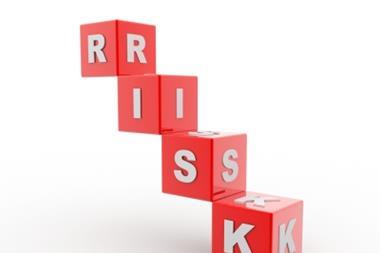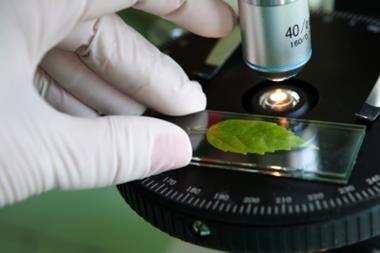Insurers are having to learn to keep pace with fast-moving scientific developments such as nanotechnology

The year was 2003. Scientists Andre Geim and Konstantin Novoselov were playing with flakes of carbon graphite and sticky tape. Seven years later, their ‘game’ was recognised with a Nobel prize in physics and their discovery, graphene, has been dubbed the wonder material of the century. This is an example of modern-day nanotechnology at its best.
Graphene, a single layer of carbon atoms, is the thinnest and strongest known substance. A square metre of graphene is a thousand times thinner than paper, and yet a hammock made out of the material would be strong enough to support a 4kg cat, while weighing no more than one of its whiskers.
Graphene is a good conductor of electricity and heat, and is flexible. It can block the smallest atom of gas – helium – but allow water vapour to pass through it.
Graphene’s potential
With these kinds of properties, the potential for graphene is huge. Current research innovations that use the material range from new types of flexible electronics that can be folded or worn on clothes, to a new generation of very small computers and mobile phones, and hyper-efficient solar panels.
Exciting as these developments are, though, new products using the ‘miracle material’ will remain in the depths of the research and development lab unless the end products can be insured.
Swiss Re senior risk engineer Roland Friedli says the pace of scientific development has never been faster and is keeping the insurance industry on its toes.
“Which is why insurers have a responsibility to keep pace with emerging developments such as nanotechnology,” he says.
Swiss Re was one of nine (re)insurers that contributed to a CRO Forum Emerging Risks Initiative position paper on nanotechnology, which concluded that a comprehensive review of the lifecycle of such materials was the key to coping successfully with the risks associated with nanotechnologies.
Danger levels
Friedli says: “We don’t see nanotechnology as a risk per se, but we see it as a technology that has the potential to change the insurance landscape in the coming years.”
Crucial to coping with this change is identifying which types of products and industries using nanotechnology have the highest exposure to risk, and at which point in each product’s lifecycle the risk is highest.
Insurers and scientists agree that nanoparticles present a lower risk when they are bound together compared with when they are airborne. Based on this, the chemical industry presents the highest level of risk from an insurance perspective, followed by the cosmetics and personal care industries.
Other end of the scale
On the other end of the scale, the automotive and electronic industries are the least risky.
“A low exposure potential arising from carbon nanotubes used in memory chips in the IT industry contrasts with the medium exposure potential of carbon nanotubes used for therapeutics within the pharmaceutical industry,” the CRO report states.
Similarly, each stage of the product lifecycle – from research and development through manufacturing to consumer use and disposal – presents a different kind of risk.
Friedli says: “Swiss Re sees the majority of the risk in the production field, where workers can be exposed to nanoparticles if they are not protected adequately.”
By the time the product reaches consumers, the risk is much lower, Friedli says, but this increases again at the end of the product’s lifecycle. “The environmental impact from the product being created and being disposed is an area that is not well understood or investigated yet,” he says.
Research into risks
The biggest concern, however, is that there has been no conclusive research into the risk of nanotechnology to human health, the environment, and financial stability.
This has led some naysayers to suggest that nanotechnology could be the next asbestos. In the 1950s and 1960s, asbestos was seen as a fantastic material that would overcome many construction challenges.
Thirty years later, however, it was discovered that those benefits came at a serious price in terms of health, and left insurers and reinsurers to pay out millions in compensation claims.
“No one wants to see another asbestos,” says Zurich head of underwriting for SME Russell Corbould-Warren. “The industry is much more wary of the long-term risk with any new development.”
But just as there are risks with nanotechnology, there are also significant opportunities for insurers. Munich Re report Focus on: Nanotechnology points out that, from a loss perspective, “nano-altered products could reduce insurers’ exposures in several areas”.
For example, cars made using nanomaterials would be safer (lighter and stronger); buildings would be more flexible and less prone to weather-related damage; bridges and other structures embedded with nano-enabled sensors could report structural deficiencies; polluted sites would be easier to clean; and medicines would be less expensive and more effective.
Health and medicine
Indeed, some of the most promising research in the field of nanotechology has been in health and medicine – the technology is expected to revolutionise the way we detect, prevent and treat various diseases and conditions.
Medicine and diagnostic developer Roche, for example, is using nanotechnology to develop new drugs, diagnostics and delivery systems and ultra-high-strength materials.
The firm is a founding member of the Nanomedicines Alliance, a consortium of pharmaceutical companies that aims to promote and facilitate the development of nanomedicines and medical nanodevices for the diagnosis, treatment, and prevention of disease and injuries.
“The risks and benefits of nanotechnology have to be carefully evaluated, especially if it is to be implemented in medicines or therapies,” Roche says in a position statement.
“Roche’s goal is to help alleviate human suffering caused by diseases. Nanotechnology has the potential to play a role in that mission – and nanoscale materials have indeed been used in certain instances for many years in Roche’s products in pharmaceuticals and diagnostics.”
Regulatory challenges
In fact, nanoscale materials have been used in products – from computer chips to sunscreen – for many years. This means that insurers are already, knowingly or unknowingly, assuming risks associated with nanotechnology every day.
At the last official count – in 2011 – the list of nano-altered consumer products had exploded to more than 1,300 products, which was an increase of 521% since 2006.
This growth is only expected to continue, and by 2020 about $3trn worth of products are predicted to have some sort of nanotechnology embedded in them, and the process to create them will involve about six million workers.
Call for standards
All this rapid progress means that, in some instances, the pace of growth is outpacing that of regulation. There are, therefore, calls for insurers to work with governments and private businesses to fund the creation of ISO nanotechnology standards.
“Those standards could apply to different industries and different nanotechnologies,” says City University London photonics lecturer Arti Agrawal.
“What this would do, apart from mitigating the risk a little bit, is make sure that there is interoperability, and that it is a global rather than a local market.”
Whether it is using nanotechnology to create flexible mobile phones or to develop improved medicines and diagnostics, insurers’ understanding of the risks involved is vital to industry development.
Risk itself is a major barrier to innovation. Taking a risk, however – as Geim and Novoselov did with graphene – is almost always the first step in any type of progress.




















No comments yet